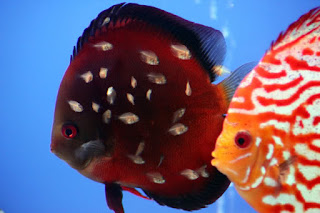Discus are big eaters. You should feed your fish three to five times a day. Some discus owners have automatic feeders that release the food at prescribed intervals.
Discus
fish food may consist of a variety of foods, including flakes and pellets, as well as live brine shrimp and black or white worms.
So,
which kind of food is best? A mixture of food types works well to
give them all the nutrients they need. The simplest and easiest
feeding routine would be to stick with dried flakes and pellets (make
sure you soak the pellets before introducing them into the tank for
your fish so that the pellets don’t expand inside the discus’s
stomach). Add some frozen or live food occasionally for variety.
Discus
are grazers. They don’t always gobble the food as it drifts to the
bottom of the tank. They eat slowly, but often, so they will eat the
food that makes it to the bottom of the tank. Therefore, it is
important to make sure you keep your aquarium clean, changing out the
water on a regular basis. This will remove rotted or decaying food
wastes as well as the fecal matter from your discus fish.
Younger
fish will need more frequent feedings to grow properly, because their
stomach is not as large as the more mature fish.
Beef heart is a common food mentioned around discus discussions. Basically, it’s cheap, and many hobbyists make their own food using beef heart. They simply grind up the beef heart with a mixture of other ingredients, then freeze it in a ziplock bag. At feeding time, a small piece of the frozen mixture is broken off and put into the tank. This mixture may include vegetables and vitamins as well as the necessary protein. It is important to mention that pure protein is not a healthy diet for discus. Beef heart, if used, should be a mixture, not just pure meat.
Live
white worms and black worms are also used by some as a food in their
tank. These can be obtained from your fish store, or, if you are
really ambitious, you can breed them yourself. But this is probably
something done by only very dedicated discus keepers.
You
do want to be careful not to make your fish sick. Live worms can
carry bacteria, heavy metals, and parasites that will wreck havoc in
your tank.
Until
you are really well acquainted with your discus fish and their
requirements, you should stick with food from the fish store. As you
become more familiar with the fish, you can experiment with adding
different foods to their daily diet.
Categories:
best discus food
best food for discus
best food for discus fish
discus fish food
discus fish food recipe
discus food
discus food recipe
food for discus
food for discus fish
what to feed discus fish
Read More












